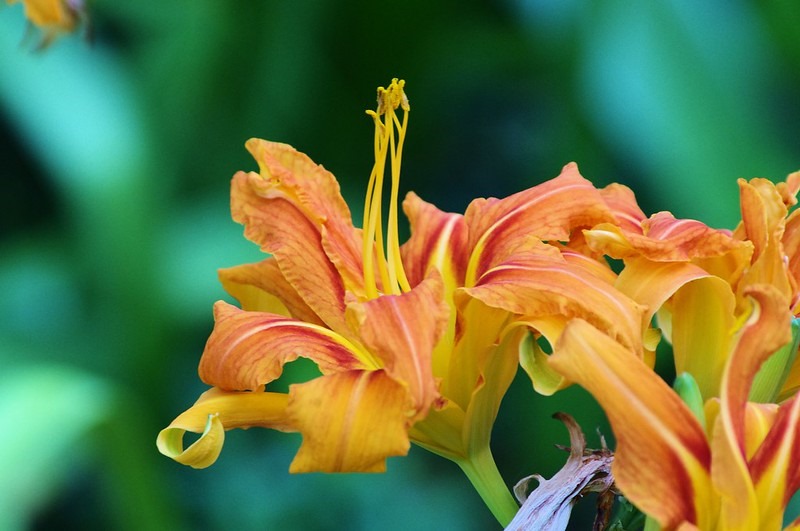Royalty-free images by Mike1 — No. 95 of over 1200 images

Orange Daylily, West-Central Arkansas, June 25, 2011
This image is from our property.
Hemerocallis fulva2
Hemerocallis fulva, the orange day-lily, tawny daylily, corn lily, tiger daylily, fulvous daylily or ditch lily (also railroad daylily, roadside daylily, outhouse lily, and wash-house lily), is a species of daylily native to Asia. It is very widely grown as an ornamental plant in temperate climates for its showy flowers and ease of cultivation. It is not a true lily in the genus Lilium, but gets its name from the superficial similarity of its flowers to Lilium and from the fact that each flower lasts only one day.
It is an herbaceous perennial plant growing from tuberous roots, with stems 40–150 cm (16–59 in) tall. The leaves are linear, 50–90 cm (20-35 in) long and 1–2.8 cm (0.39–1.10 in) broad. The flowers are 5–12 cm (2.0–4.7 in) across, orange-red, with a pale central line on each tepal; they are produced from early summer through late autumn on scapes of ten through twenty flowers, with the individual flowers’ opening successively, each one’s lasting only one day. Its fruit is a three-valved capsule 2–2.5 cm (0.79–0.98 in) long and 1.2–1.5 cm (0.47–0.59 in) broad which splits open at maturity and releases seeds.
Orange daylily is native to Asia from the Caucasus east through the Himalaya through China, Japan, and Korea. Orange daylily persists where planted, making them a very good garden plant.
Hemerocallis fulva var. fulva has escaped from cultivation across much of the United States and parts of Canada and has become a weedy or invasive species. It persists also where dumped and spreads more or less rapidly by vegetative increase into woods and fields and along roadsides and ditches, hence its common name ditch lily. It forms dense stands that exclude native vegetation, and is often mistaken for a native species.
- I am sharing some of my public domain images in periodic blog posts.
- Hemerocallis fulva – Wikipedia
Notes:
- This image is also shared as public domain on Pixabay, Flickr, and Pinterest.
- Images are being shared in the sequence they were accepted by Pixabay, a royalty-free image sharing site.
- Only images specifically identified as such are public domain or creative commons on our pages.
- All other images are copyright protected by me, creative commons, or used under the provisions of fair use.

